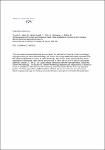Seroprevalence of human polyomavirus 9 and cross-reactivity to African green monkey-derived lymphotropic polyomavirus
Trusch, Franziska
Klein, Marcus
Finsterbusch, Tim
Kühn, Joachim
Hofmann, Jörg
Ehlers, Bernhard
Human polyomavirus 9 (HPyV9) was discovered recently in immunocompromised patients and shown to be genetically closely related to B-lymphotropic polyomavirus (LPyV). No serological data are available for HPyV9, but human antibodies against LPyV have been reported previously. To investigate the seroepidemiology of HPyV9 and the sero-cross-reactivity between HPyV9 and LPyV, a capsomer-based IgG ELISA was established using the major capsid protein VP1 of HPyV9 and LPyV. VP1 of an avian polyomavirus was used as control. For HPyV9, a seroprevalence of 47 % was determined in healthy adults and adolescents (n = 328) and 20 % in a group of children (n = 101). In both groups, the seroreactivities for LPyV were less frequent and the ELISA titres of LPyV were lower. Of the HPyV9-reactive sera, 47 % reacted also with LPyV, and the titres for both PyVs correlated. Sera from African green monkeys, the natural hosts of LPyV, reacted also with both HPyV9 and LPyV, but here the HPyV9 titres were lower. This potential sero-cross-reactivity between HPyV9 and LPyV was confirmed by competition assays, and it was hypothesized that the reactivity of human sera against LPyV may generally be due to cross-reactivity between HPyV9 and LPyV. The HPyV9 seroprevalence of liver transplant recipients and patients with neurological dysfunctions did not differ from that of age-matched controls, but a significantly higher seroprevalence was determined in renal and haematopoietic stem-cell transplant recipients, indicating that certain immunocompromised patient groups may be at a higher risk for primary infection with or for reactivation of HPyV9.
Dateien zu dieser Publikation
Keine Lizenzangabe
Verwandte Publikationen
Anzeige der Publikationen mit ähnlichem Titel, Autor, Urheber und Thema.
-
2015-09-03ZeitschriftenartikelGenome Sequences of a Rat Polyomavirus Related to Murine Polyomavirus, Rattus norvegicus Polyomavirus 1 Ehlers, Bernhard; Richter, Dania; Matuschka, Franz-Rainer; Ulrich, Rainer G.We amplified and sequenced six complete genomes of a polyomavirus from feral Norway rats (Rattus norvegicus) and from a long-term breeding colony derived from Norway rats. This virus, which is closely related to hamster ...
-
2015-09-03ZeitschriftenartikelGenome Sequence of a Central Chimpanzee-Associated Polyomavirus Related to BK and JC Polyomaviruses, Pan troglodytes troglodytes Polyomavirus 1 Madinda, Nadège F.; Robbins, Martha M.; Boesch, Christophe; Leendertz, Fabian H.; Ehlers, Bernhard; Calvignac-Spencer, SébastienWe amplified and sequenced the genome of a polyomavirus infecting a central chimpanzee (Pan troglodytes troglodytes). This virus, which is closely related to BK and JC polyomaviruses, may help shed a new light on these ...
-
2010-11-03ZeitschriftenartikelAfrican great apes are naturally infected with polyomaviruses closely related to Merkel cell polyomavirus Leendertz, Fabian; Scuda, Nelly; Cameron, Kenneth; Kidega, Tonny; Zuberbühler, Klaus; Leendertz, Siv Aina J.; Couacy-Hymann, Emmanuel; Boesch, Christophe; Calvignac, Sébastien; Ehlers, BernhardThe oncogenic Merkel cell polyomavirus (MCPyV) infects humans worldwide, but little is known about the occurrence of viruses related to MCPyV in the closest phylogenetic relatives of humans, great apes. We analyzed samples ...

